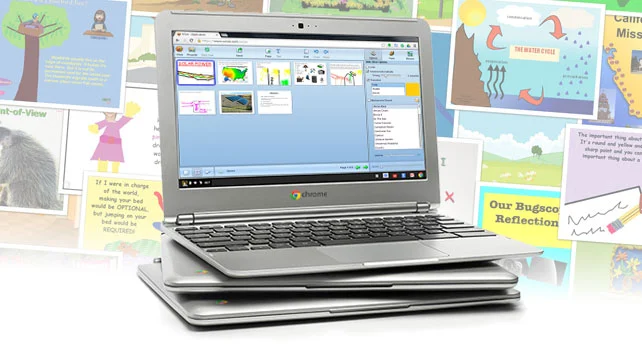

I first encountered Joseph from social media posts he was sharing of elementary student artwork created remotely during the pandemic. As I continued to follow Joseph's work in his new position teaching high school art in the Virtual Learning Program in Baltimore County Public Schools, I came to see that not only was he a gifted artist, he also had an amazing way of connecting with learners working from home, inspiring them not only to do the work, but to do it well. So, I asked Joseph to share some of his secrets to help the rest of us improve our asynchronous lesson designs.
When I was working on my Master's at Towson University, I was exposed to Khan Academy and the idea of Flipped Learning. The idea of being able to not only access video tutorials, but pause and rewind to learn more and at my own pace inspired the start of my journey and I began recording myself as I created a work of art so that I could share my process without having to be next to each student in my classes.
Like most of the country, Baltimore County Public Schools, moved to distance learning the pandemic, and then transitioned to a hybrid model before going back to fully face-to-face learning. When the County began its Virtual Learning Program I decided to teach art virtually full time.
Teaching art virtually has been great. There are so many creative apps, like Wixie, that make it fun and engaging for every age and skill set. Learning management systems also allow teachers to create lessons that supply students with a plethora of resources that support learning.
The art looks great, prints nicely, and the coloring or designs are easier and cleaner with features like a paint bucket tool, shape tools, and digital brushes and pencils. If students choose to work with low-tech materials, they always have that option and then we focus on presentation: like good lighting, picture is in focus, and cropping.
All work is submitted virtually so it lends itself well to portfolios with Wixie books or folders. I create virtual art shows through a webpage using Adobe Express and secondary students use this tool for their portfolios. No matter what they use, all students are learning 21st century skills.
I love that I can give feedback asynchronously too. In the face-to-face classroom you have to try to give everyone some feedback during class which means you don't have a lot of time to think and clarify. Because I can review their progress and share comments digitally, I can provide feedback when I have more time to reflect and clarify.
All these different digital and tangible options can make it challenging to support all learners. I try to use small groups and student- led workshops to help facilitate and make the criteria about the project and the vocabulary/techniques on display. The means for how they get to the destination is up to the students.
During virtual "studio time" I put on music and model the lesson so they can watch or work on their own. Sometimes I will ask for "proof of life," but whether the students work with me during class or do the work asynchronously for homework, they still have to get the job done.
Sometimes it gets a little chaotic as I jump into a second Google Meet so I can explain different tools to different students. It's always a balance as I try to get creative and give them as many options as I can without going crazy.
I still utilize the flipped learning techniques I learned ten years ago, and everything I do today includes a range of resources and supports for students to use when they aren't with me, such as descriptive vocabulary, sample work from students and teachers, YouTube videos and other instructional resources, and of course my own recordings.
I also monitor student progress using Go Guardian, an app our district uses, that allows me to look at screen time, websites being used or misused, and annotate their screens to help them navigate any particular app or website.
Designing for virtual learning is similar to face-to-face instruction in that you have a goal in mind, and backwards map from there. There are many factors that go into learning and like my face-to-face classroom, I start every class with a mindfulness activity and talk about the importance of self-care.
The difference is that you have more time to focus on your students and curriculum. You are not tasked with bus, hallway, or lunch duty. You do not have to cover other classes all the time. You can message parents, students, and design high-quality lessons with the extra time.
Asynchronous resources and opportunities make it easy for me to differentiate and easily build small group activities. In Baltimore County where I teach, all students have devices, so this provides a great opportunity for both acceleration activities and reteaching.
Because I can't just drop in and have conversations as easily in the virtual environment, I work hard to provide individualized feedback that connects to the criteria and rubric. This way, even if I am not there, my students can understand why they got the grade they did. Extensive feedback combined with clear expectations benefits learning, no matter where it is.
I will continue to allow my students to revise work and resubmit. My philosophy towards teaching and learning is a "growth mindset." Just because students did not complete an assignment to match up to the criteria, directions, or deadline, doesn't mean that they can't or that that ship has sailed. When I allow my virtual students to revisit their work, utilize the resources and myself, and resubmit to better their grade, they almost always show a higher level of understanding of the techniques or concepts. This is the goal of teaching, no matter where it takes place.

Follow us on Instagram for daily inspiration

Create a thought web, timeline, flowchart, or other graphic organizer for a lesson


Wixie
Share your ideas, imagination, and understanding through writing, art, voice, and video.

Rubric Maker
Create custom rubrics for your classroom.

Pics4Learning
A curated, copyright-friendly image library that is safe and free for education.

Wriddle
Write, record, and illustrate a sentence.
Topics